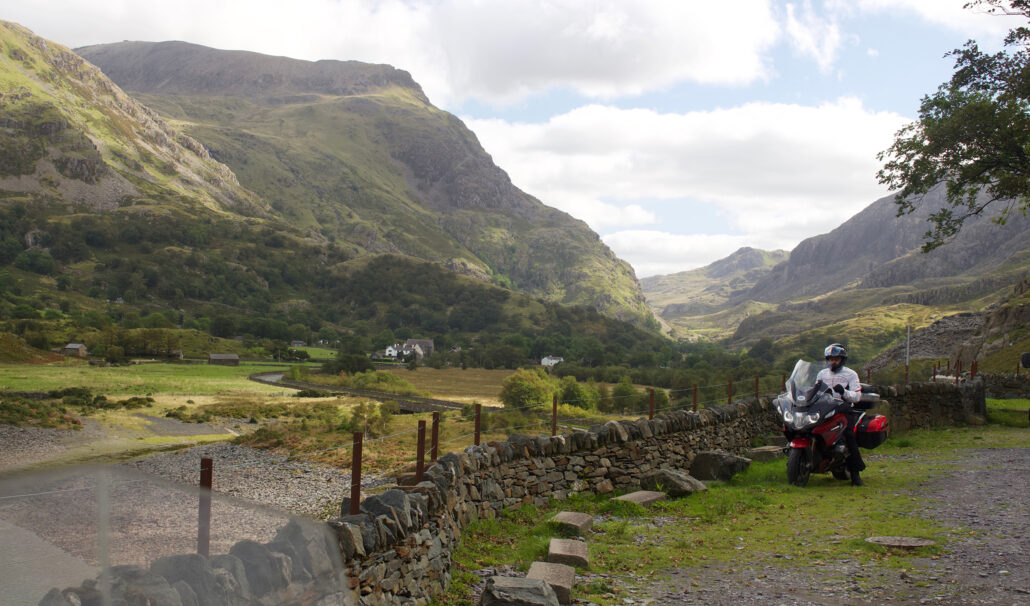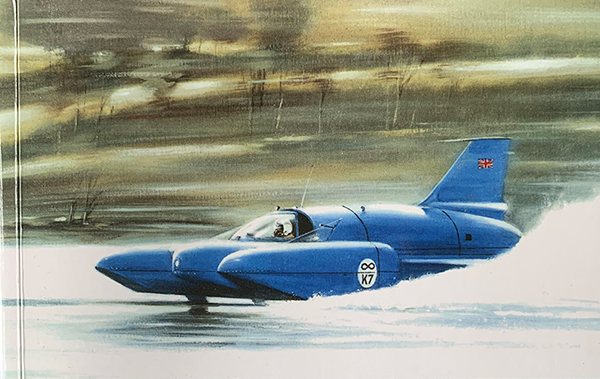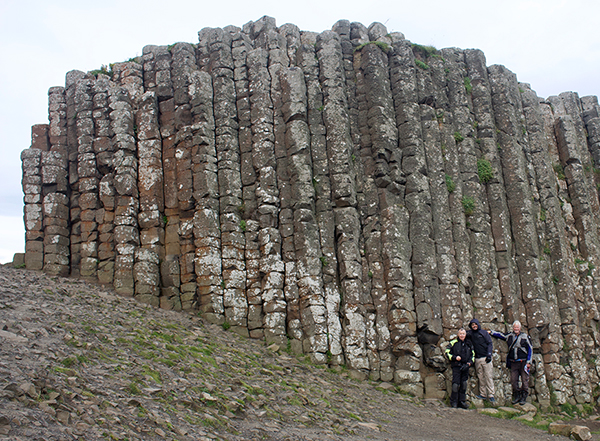AMERICAN MOTORCYCLIST January 2020
Great Britain and Ireland Ride
20 Days Amid The Beauty Of The Islands

The author takes a break in the Welsh hills.

Simon Keitch
With my two long-distance riding buddies (Forrie from New Zealand and Ahmed from Kuwait), this was to be a 20-day ride that started and finished in my back yard—2,250 miles around England, Scotland, Ireland and Wales.
True, we barely dipped our toe in the splendor of Scotland, but to make up for it we rode the length of England, traversed Ireland from sea to sea, and surged down Wales from the very north to the deepest south.
When this route was suggested, I was lukewarm to the idea. It felt a million miles from the adventurous rides we’d enjoyed across South America, New Zealand and, most recently, the Republic of South Africa. But excitement on two wheels is enticing wherever the road leads.
Furthermore, my buddies had never motorcycled in GB&I, and, as the obvious candidate for organizing, I had enough concerns to keep my interest at peak level.
Chief among my anxieties was the British weather. Our islands are classified as “North East Atlantic Maritime.” And our weather is defined neatly as “winters cool and wet; summers warm and wet.” The repetition of the word “wet” is a clue.
On a loaded bike, as every biker knows, rain—especially persistent rain—is exhausting and uncomfortable. Also, we’d chosen September. Late summer, if you were lucky, early autumn, if you weren’t. We could expect pretty much anything.
As it happens, we met up at Heathrow on a warm and pleasant afternoon, and the sun was shining as we picked up Ahmed’s and Forrie’s rented bikes from Road Trip in Woking.
They’d been offered a huge range of machines and chosen BMW tourers—an R1200RS and an R1250RT—with me happily riding my old faithful Triumph Tiger 800.
We set off the next morning in more sunshine for the easy run to Bletchley Park, home of the famous WW2 code breakers, and spent the afternoon surrounded by captured signal books and early computers.
Coniston Water
The following day we continued north—still in good weather—to stop the night in the village of Hope, set in one of England’s prettiest national parks, the Peak District.
Now the rides got longer, as day three—sadly in heavy rain—took us to Windermere in the gorgeous Lake District, a mostly freeway route past the huge built-up areas of Manchester and Liverpool.
Well, as one local said, if there was no rain there’d be no lakes, and we cheerfully put up with getting wet for the beauty and tranquility of this magnificent corner of England’s Northwest.
We had a couple of nights here, and our “unloaded” day included a beautiful ride to Coniston Water, a lake so deep and quiet it was chosen for several attempts at the world water speed record in the 1950s and ‘60s.
Growing up then, one of my heroes was the dare-devil Englishman Donald Campbell, the only man ever to hold world speed records on land and water in the same year. He set a land record of 500 mph—at Bonneville, where else?—but was killed on Coniston Water when his boat “Bluebird” somersaulted attempting 300 mph.
On to Scotland

The Bluebird at speed
After paying our respects at the Coniston Museum, we continued north to Scotland, coming first to the small border town of Gretna Green.
The old blacksmith’s shop here doubled up as a marriage chapel, and for years was the destination of many a young runaway English couple, looking to take advantage of Scottish law. I actually have a cousin—Anne—who did just this, running away at 16 to marry her sweetheart, when her parents wouldn’t give their permission.
We stayed two nights in the pretty market town of Moffat and enjoyed some nice “unloaded” rides through the Galloway countryside before heading west to Cairnryan to catch the ferry across the Irish Sea to Larne.
The N2 from here along the Antrim coast to Bushmills is the beautiful twisty road that the great Irish racer Joey Dunlop cut his teeth on. Joey is revered by fans of road racing the world over. He won an astonishing 26 Isle-of-Man TT races and was Northern Island GP champion a record 24 times. It was exhilarating to know we were riding “his” road.
Bushmills was our actual destination that evening. It was hard to resist the charms of the world’s oldest whiskey distillery, followed by a walk the next morning to the Giant’s Causeway, a UNESCO world heritage site.
Here, an ancient volcanic eruption formed 40,000 interlocking basalt columns, mostly hexagonal, some as tall as 40 feet, an unforgettable phenomenon, and one of the most visited tourist sites in the British Isles.
We continued west, riding to the top of Lough Foyle for the short ferry ride across to Greencastle, and our first stop in Ireland (officially “Eire”).
The border runs through the middle of the Lough, and with the ups and downs of Brexit in its closing stages in London and Brussels, we wondered if this particular section of the border would be hard, soft or maybe medium.
In reality, it appeared to be nonexistent. We rode on, parked our bikes, and rode off uneventfully, road signs in kilometers being about the only indication that we were in a whole new country.

Wheaton, Forrie and Ahmed on the Giant’s Causeway Bottom: Conwy Castle
Ireland
Certainly, the people remained as friendly, and once again (this being my first Irish visit on two wheels) I found myself answering the inevitable “So, where are you from?” with “I’m English, and I’m sorry.”
This usually got a smile, despite my country’s hundreds of years discrimination against these friendly and hospitable people.
We rode the lanes of Donegal, through pretty villages and along it’s superbly indented coast, aiming that night for a hostel on the outskirts of Dunfanaghy.
This charming little town hosted a jazz and blues festival that weekend, so—as the trip organizer—I must admit to a major blunder. The plan called for a taxi ride into town (the festival having filled all local accommodation months ahead) with a cruise of the pubs and clubs, listening to the aforementioned jazz and blues.
Sadly, two things went wrong. First, it rained. Proper rain! The streets were awash. Some tented venues lost power, while none of the outside venues were open, and all of the indoor ones were jam- packed.
Second, there was little in the way of the advertised music—only heavy rock pumped out at maximum volume.
After an hour or so, we gloomily taxied back to the hostel, where we discovered the gorgeous sound of a traditional Irish band playing upstairs.
We dashed up, to find a bunch of youngsters, ages 12 to 17, playing two violins, guitar and flute, regaling a pizza restaurant (wood-fired oven crackling away in the corner) with their wonderfully instinctive, foot-tapping music.
We sat down at 8:55 exactly. I know this because at 9 p.m.—their watershed—the kids stopped playing and packed up their instruments. I kicked myself for the miscalculation and regret we didn’t hear more of that delightful traditional music.
We continued around the coast the next day, stopping for a delicious lunch at the back of one of Donegal’s endless and sparklingly clean beaches, easily imagining the Atlantic breakers starting their life 3,000 miles away off the coast of North America.
That night we reached Belleek, right on the border between the two Irelands, and the site of one of the last Irish battles against the English. More apologies given, and more apologies refused, the pub there giving us one of our best dinners and pouring the smoothest Guinness.
By the way, if any American Motorcyclist readers enjoy a pint of “The Black Stuff” now and then, you’re in for a treat if you’re lucky enough to try one in Ireland. They’ve been making it there since 1759.
We rode clean across Ireland to Dublin. An easy ride and uneventful, apart from the improving weather.
We’d never been cold on the trip, but we felt we’d had our fair share of “warm and wet,” and the long-term forecast was hinting at a slowly moving dry spell that might sit over the British Isles for a week (It did!!).
Dublin, Wales, then home
We rode into Dublin in bright sunshine, and started to wish we were staying longer. Our tickets for the ferry to Wales timed for 8 the next morning.
We had a quick shower in our city apartment and headed out in search of civilization, as in a nice meal and—just maybe—a pint of the black stuff. Of course, the Guinness brewery itself is in Dublin, open to the public for a hefty fee, and a good place to wander, we thought.
In any event the over-crowded, self-guided tour was a let-down. We’d grown to expect proper hospitality in Ireland, and this felt a bit skimpy.
Early the next morning, our last in either of the Irelands, we made the four-hour crossing of the Irish Sea to north Wales, in sunshine so bright it hurt our eyes.
Wales is beautiful and a pretty densely mountainous corner of Britain: Mount Snowdon is 3,560 feet high! (Please don’t laugh if you’re from Colorado or Alaska.) And it’s absolutely seen at its best in the sunshine.
First stop was Conwy, where 700 years ago the English built a magnificent castle as part of their plan to subdue the pesky Welsh. We walked the massive and imposing battlements, marveling that something built in 1280 could still be in such fantastic condition, and, in my case, guessing that 700 years of history took away any need to apologize.
We spent two nights in north Wales, followed by a delightfully sunny, warm and dry run south to the Brecon Beacons, under cloudless skies all the while.
Here, in the village of Ystradgynglais (good luck pronouncing that) BMW runs its famous off-road skills school, where Ahmed and Forrie had organized some world-class instruction in a few square miles of the most beaten-up, rocky, muddy and forbidding landscape on the planet.
I happily ducked out and spent a couple of days with my feet up, reuniting with my buddies for the final 200-mile leg to my home in Exeter.
By the way, if any reader is still trying to pronounce “Ystradgynlais,” spare a thought for the Englishman who needed a translation for a “No entry for heavy goods vehicles” bilingual road sign. He emailed his request, and the reply “Nid wyf yn y swyddfa ar hyn o bryd” was duly incorporated, for him to discover—weeks later—that it read: “I am not in the office at the moment.”
Back in the lovely southwest of England, those last few days on my home turf gave me time to unwind, and reflect on our ride.
I particularly remembered something I’d come across years ago in a “Lonely Planet” guide book. In it, I was surprised to read that the British Isles were described as “quite simply, some of the most beautiful islands to be found anywhere in the world.”
Surely not, I’d thought. But they are, and seeing them partly through my buddies’ eyes—the tranquil lakes, the hills of Scotland, the Irish coast, the mountains and castles of Wales, the deserted moors of the southwest—made me realize that, actually, my own back yard really is rather special.
Rick Wheaton is an AMA member who writes about motorcycling and touring the world over.


